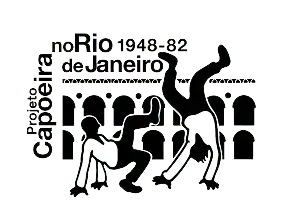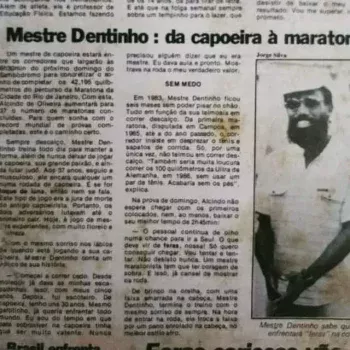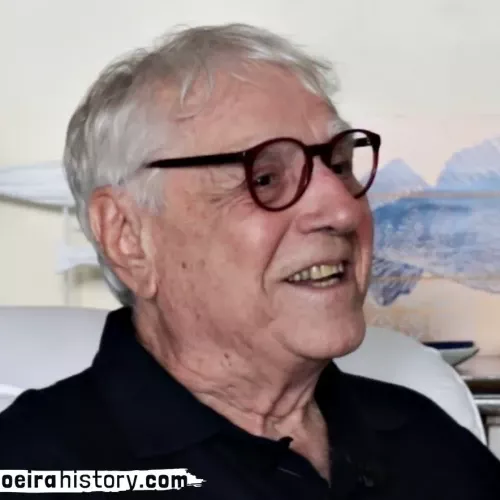Alcino Oliveira Bemvindo was born on June 25, 1952, in the state of Espírito Santo. He started practising judo at the age of two, moved on to jiu-jitsu and only later learned capoeira, where he became known as "Dentinho".
Master Alcino Auê.
Master Dentinho conquered Brazil and the world with his capoeira Angola style from Penha – the name of the neighbourhood where he lived in Rio de Janeiro. He developed a unique style of playing, presenting a fearless and joyful capoeira. He was an authentic and true capoeirista, who did not allow the opponent to foresee his next kick.
Playing high and low, he spun with almost imperceptible speed. He used his cunning and trickery (malícia) to hit and defend himself. He never remained in one place, nor did he give his opponent much space to think. He only performed the ginga when necessary and used his swing to strike and improvise sequences within the basic movements of capoeira. He had an enviable breath and played without stopping, training to exhaustion.
The capoeirista
In the 1960s, Mestre Dentinho was the first capoeirista to make a somersault in capoeira rodas in Rio de Janeiro. The novelty happened in the roda of Quinta da Boa Vista and caused a certain conflict with the other capoeiristas, who tried to catch him while he was performing that jump!
During the 1970s, Mestre Dentinho was an important and regular presence at the famous roda of Zé Pedro‘s, on Sundays, in the Bonsucesso neighbourhood.
In 1973, Mestre Dentinho was part of the “unbeatable team” – the Guanabara team – which conquered the 1st. Brazilian Capoeira Championship, winning the competition in the individual and team modalities. In 1975, he came 3rd in the musical Festival de Toque e Chula of Rio de Janeiro.
He was the founder of the capoeira groups Auê, active in Rio de Janeiro and Italy, and Cinamar, with groups in São Paulo and in the United States.
Photos: Masters Alcino Auê and André Lacé collections.
Art and fight
Mestre Dentinho survived the repression against capoeira, and gained recognition for his talent, but could not make a living exclusively from capoeira. In the 1970s, for instance, he worked on the docks in Rio de Janeiro as a stevedore. As he himself explained, “it was difficult for a capoeirista to get a regular job, with a work contract. When I got a job and the company found out I was a capoeira practitioner, they would sack me”.
He has also participated in various types of shows. Even without much knowledge of acrobatics, Mestre Dentinho stood out for his corporal dexterity, for example, he made a point of showing his talent in performances, where he executed the somersault from a seated position, or even tied up with ropes.
Photos: Alcino Auê collection.
Running
In the 1960s, Dentinho began practising outdoor running. During his life, he took part in more than five thousand competitions, such as the São Silvestre International Race, in the 70s, and the Marathon that was part of the United Nations Conference on Environment and Development, held in 1992, in the city of Rio de Janeiro, the Eco-92.
Always running barefoot and wearing his well-known ragged costume, Dentinho’s presence in the races drew the attention of journalists who made him the subject of several articles.
Photos: Masters Alcino Auê and André Lacé collections.
Recognition
His capoeira game, marked by spontaneity, expressiveness and a lot of cunning (malícia), didn’t stop Mestre Dentinho from receiving institutional recognition for his talent:
- On May 15, 1976, the Carioca Pugilistic Federation formalised, through a diploma, his title of Master of Capoeira, a green and white belt.
- The Municipal Council of Rio de Janeiro, on April 16, 1988, offered him a motion “for relevant services rendered to capoeira in Rio de Janeiro”.
- The Legislative Assembly of Rio de Janeiro State honoured him with the Diploma Zumbi dos Palmares, in 2009.
- Deep knowledge of the history and art of capoeira, Mestre Dentinho was invited to give lectures in several universities, such as UFRJ, UERJ and Estácio, in Rio de Janeiro.
- The monument “Homens de Fibra”, in honour of the brothers Touro and Dentinho was inaugurated on October 30, 2021, in the neighbourhood of Penha.


Master Dentinho turned his dancing into his ginga. With his unique style of cunning, malícia, and a lot of expression, he conquered everyone who saw him in action. A person of great education and simplicity.
The plasticity of the movements of an old performance by Dentinho inspired the artist to create the Men de Fibra monument, erected in Largo da Penha, Rio de Janeiro, in honor of the brothers, “giants capoeira carioca”, Mestres Touro and Dentinho.
Fotos do acervo Alcino Auê.
The game
The video on the left gives us a quick example of the game played by Masters Dentinho and Hulk, at the Roda da Penha, in 1998. And also, on the berimbaus, Mestres Nacional and Medeiros.
Available on the Sidney Freitas YouTube channel.
Alcino Vieira Bemvindo – Mestre Alcino Auê – comes from a traditional family of capoeira players that has its name engraved in history – the Bemvindo family. Just like his uncle, M. Touro, and his father, M. Dentinho.
















